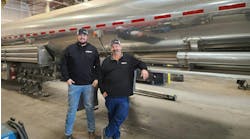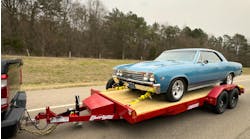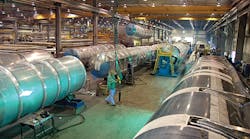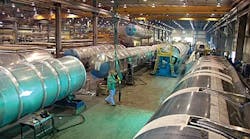KEEPING UP with demand for tank trailers the past two years has been like trying to change your motor oil with the engine running.
So says Ted Fick, president of Polar Corporation, the company that owns Polar Tank Trailer, Polar Service Centers, and Quality Trailer products. In response to present and projected demand for tank trailers, the company is investing heavily in technology, machine tools, expanded facilities, and personnel.
“The tank industry has bounced back sharply from 2009, which was the worst year in our history,” Fick says. “Combine pent-up demand for tanks that went unmet during the downturn and the explosive growth in oil-related business, and there has been a huge need for us to figure out ways to improve our throughput.”
Figure it out they did. With minor additions of manufacturing space and major additions of machine tools, Polar has invested approximately $10 million during the past 18 months to boost production, improve quality, and enable its three trailer manufacturing plants to respond more rapidly to changes in the needs of the market.
“For the past 18 months, it really has been like changing your oil with the engine running,” Fick says. “We've been expanding our plants, integrating 800 new people into our company, and relocating a hundred pieces of equipment in our facilities in an effort to find more efficient ways to produce trailers. All of this has been going on while trying to keep up with record demand for tank trailers.”
Polar weighed a number of options to meet demand, including outsourcing some of its operations.
“We have always been vertically integrated,” Fick says. “Doing that requires heavy investment in machine tools
to produce the parts and components that our trailers require. To justify these machines, you need to keep them running 24/7. Rather than outsourcing our fabrication and potentially reduce the utilization rate of our plant equipment, we chose to continue to fabricate as much of our product as possible.”
In part, that meant significant new investment in new manufacturing technology. In its Springfield, Missouri, plant alone, Polar has added a high-definition plasma cutting table, CNC roll, flanging machine, and CNC tube bender to form the network of pipes its tank trailers require. The flagship plant in Opole, Minnesota, has added a laser cutting table and robotic welding cell, while the Holdingford, Minnesota, has been upgraded to high-definition plasma. All three plants have been enlarged, anywhere from 5,000 square feet in Holdingford and approximately 30,000 square feet in both Opole and Springfield.
Integrated engineering, production
Each of these steps has helped Polar achieve its goals, but management says that the real benefit came by integrating its machine tools with its new 3-D Inventor engineering software.
The software, similar to Solidworks CAD/CAM software, is becoming the standard among trailer manufacturers, says Jim Painter, president of Polar Trailer, the trailer manufacturing operation of Polar Corporation.
Painter quickly gives bullet points why his company has implemented the system that they chose:
- Detect design problems before they occur
The three-dimensional allows engineers to see their design from all angles, making it possible to identify potential interference and other conflicts.
- Seamless transition between design, machine tool programming, and layout
The software designs the product, programs the CNC equipment that fabricates the parts, and marks where parts need to be placed.
“We can design the product in its final form and then automatically lay out dimensions in the flat and program the high-definition plasma,” Painter says. “But we also use it to scribe the flats. Here's an example: 3-D Inventor defines where the rings of our crude oil trailers go, and the high-definition plasma scribes the lines. We can put away the sharpie because the layout lines are already there. Just weld the ring on the scribed line. That saves time, and it also results in less variation.”
- Precision fit-up
Polar recently used its 3-D software to redesign the undercarriage of its trailers. “We were able to change to a tab and slot design,” Painter says. “The rail has a slot, and the cross sills have a tab. It all fits together as an assembly with tight tolerances. In Opole, we have had added a robotic welding cell to produce it. The design software, though, makes it possible.”
To date, the Opole plant has the only robotic welding cell. Springfield uses the same type of high-definition plasma to fabricate the tab and slot design, but the welding is done manually.
“Will we eventually set up a similar robotic welding cell in Springfield? Probably, but we want to make sure we are completely happy with the technology first. It's a big
investment,” Painter says. “And, of course, low-volume components probably will always be done manually, no matter which plant builds them.”
Upgraded machine tools
The beauty of today's sophisticated design software is its ability to then generate the programming that the machine tools require to fabricate the part. Polar has spent both time and money the last 18 months installing a series of CNC machines, particularly in the Springfield facility.
This summer saw the arrival of a high-definition cutting table, along with a flanging machine designed to make the Springfield facility self sufficient in terms of producing the heads used in tank manufacturing.
“The oil boom has led us to build a lot of crude oil trailers recently,” Painter says. “Enabling Springfield to fabricate the heads that these types of trailers require has made this plant more flexible and has reduced response times for this type of product.”
These two machines join several other equipment acquisitions the plant has made as part of Polar's upgrade program. The plant also has a new CNC elliptical barrel roll to form the barrel and a CNC pipe bender to shape the piping that Polar tank trailers require.
Polar sees a big difference between standard plasma and high-definition plasma technology.
“We don't need to grind cuts made by a high-definition plasma,” Painter says. “Yes, that saves time and eliminates an additional process, but the real advantage is quality. By eliminating the need to grind, we also remove the human factor — the risk of over or under grinding. We get a better fit, and we don't need to do any blacksmithing because everything is dimensionally correct.
Much of the improvements are directed at the quality of the barrel and the heads. Polar recently spent $125,000 upgrading the hydro press used for fabricating the heads, along with the separate machine for making the flange. The upgrade is consistent with what Polar is striving to do throughout its operation.
“We could have met our capacity concerns for $500,000 less than what we have invested here, but we would not have achieved our objectives. The improvements we are making companywide are not just efforts to make enough trailers to meet demand. We want better quality and more consistency.”
Needing more room
Polar has required a little more space to keep up with trailer demand, but the company has been able to use that space for a significant increase in production lines and flexibility.
For example, the Springfield plant was expanded by 27,000 square feet, but with the additional space, the company was able to create six assembly lines instead of the previous three. In its current configuration, the plant is using the extra lines in order to have three lines to produce crude oil tanks. But that's not the point — the point is to have the flexibility to produce the proper mix of tank trailers that the market demands at any given time.
“The oilfield is going strong,” Painter says. “Demand is high for crude oil tanks to transport oil from the well. And with changes in drilling technology, there is also strong demand for dry bulk trailers to deliver sand for fracking operations. We also build petroleum trailers that deliver refined products. The production side of the oil industry and the petrochemical side are two different markets that don't always move in the same direction. Our plants have to be capable of handling changes in demand for different products. We have been working to achieve that as part of this program we have implemented over the past 18 months. We need to shift from crude oil tanks to dry bulk, from dry to petroleum, from petroleum to crude. Our goal has been to increase our flexibility along with capacity.”
Other additions
Polar made a similar expansion to its Opole facility and added 5,000 square feet to its plant in Holdingford. The Opole expansion gives the plant a second barrel line. The result is separate production of aluminum and stainless steel barrels. And with the expansion, the plant has moved from a stall-built system of finishing to more of a line-built operation.
“All final operations were done in a bay at Opole. Undercarriage, pipe, wire, platforms,” Painter says. “We have changed that. Probably 70-80% of our production will be finished this way.”
One of the focal points at Opole has been the robotic welding cell. In order to improve efficiency, the company's laser cutting system was moved near to the cell, and dedicated wash and paint booths were created specifically for the undercarriage cell.
The Holdingford plant received a modest expansion. The company built a separate warehouse to house inventory that had been inside the plant. Polar removed a wall that had defined the warehouse and then opened up the floorspace for additional production.
Upgraded ERP system
Another piece of Polar's plan is an upgrade to the company's ERP system.
“We are doing a much better job of scheduling between our suppliers and our plants,” Painter says. “We barcode everything now. Instead of manually inputting data after we receive it, we scan the barcode and get the information into our system in real time. Under our manual system, that information sometimes did not get entered until a day or two after the shipment arrived. As fast as things move around here, that may be too late.”
Even something as basic as supplies need in the plant. Polar is working with Fastenal to stage consumables, hand tools, and other small items at the point of use. A series of vending machines and electronic lockers save space and reduce lost motion.
“We now have 45 of these devises in our three locations,”
The vending machines dispense consumables such a abrasives, drill bits, saw blades, work gloves, and other small items. Painter says. The supplier owns the contents of the machines until the product is dispensed from the machine.
Polar and Fastenal worked to set up the types of products dispensed, along with permission criteria for making a purchase and dollar limits per transaction The machine verifies that the individual is authorized to make such a purchase and automatically charges the appropriate cost center. If employees need to exceed their limits, the foreman must authorize it. Management receives weekly reports.
Restocking the machines
The system has the ability to place orders via e-mail. It also addresses seasonal swings in consumption of some supplies that may not be related to company demand.
“According to a consultant who helped us with this project, a lot of companies see demand for batteries spike as Christmas approaches, and it's not uncommon for companies to see office supplies jump when school starts,” Painter says. “A system like this builds accountability and enables us to have an accurate picture of what we have in stock. It quickly shows us what our buying patterns are so that the plant can rely on the supplies being there. If a plant frequently runs out of tools and supplies, people tend to hoard them. It's interesting that once people are confident that the items they need will be on hand, the hoarding stops. Management should give its workforce a level of support that is equal to its expectations of its employees. We owe it to them to give them the tools they need to do the job that we ask of them.”
Polar uses electronic lockers in addition to the vending system. That, combined with the vending machines, enables production workers to get what they need without venturing far from their stations. Working with its vendor, even kits of trailer components can be brought together and dispensed right there where they are used.
“The system operates on a radio frequency much like a wireless computer network,” Painter says. “When we reach our minimum stocking levels, the system sends a signal to reorder. That signal goes to our server and then to Fastenal. It's quick. We are never more than a half shift away from resupplying.”
Wrapping things up
It's been a very busy 18 months around Polar. On top of plant expansion, redesigned plant layouts, new equipment acquisitions, the company has increased the number of employees from right at 1,000 two years ago to 1,800 today.
“It's been a real challenge keeping up with demand,” Fick says, “but we are in a great position now. We have made significant upgrades to all three of our plants and have achieved what we set out to do. And the tank trailer industry has enjoyed strong growth in 2010 and 2011. We are expecting a record year in 2012. There's a big appetite for tank trailers.”










